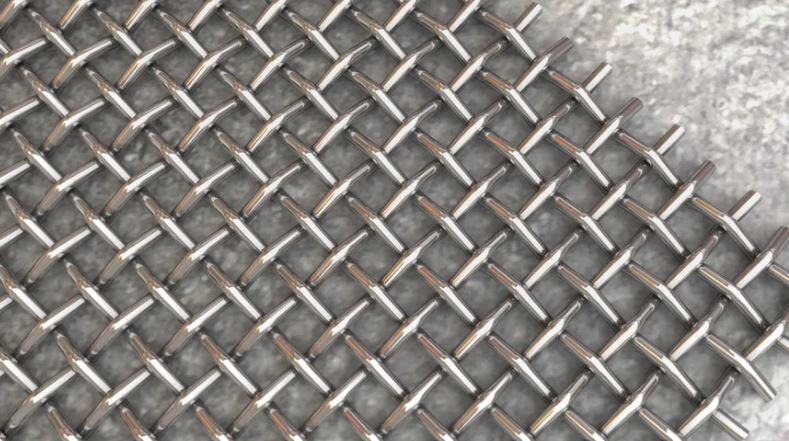Woven Wire Mesh in Electromagnetic Shielding: Understanding the Value
There is no denying that reliable electronic systems that perform uninterrupted are the foundation of today's industrial landscape. From satellites orbiting around the globe to MRI machines that help us maintain our health, there is one common concern—electromagnetic interference (EMI).
To keep the effects of these interfering signals at bay, engineers must implement electromagnetic shielding elements in and around sensitive electronic systems.
Why? Well, put simply, electromagnetic shielding components protect your sensitive equipment by disrupting electromagnetic energy.
There are a handful of materials that can be used to facilitate this shielding. But there is one unsung hero that delivers the perfect balance of performance, cost-effectiveness, and versatility:
Woven wire mesh.
Here at W.S. Tyler, we continue to lean on our 150 years of woven wire mesh experience to innovate and provide engineers and manufacturers with high-performing wire mesh. This helps empower people like you to meet the ever-evolving demands associated with protecting the electronic devices that make the world go round.
For this reason, the following article outlines how woven wire mesh fits into the most common electromagnetic shielding applications, equipping you with the base knowledge needed to make informed decisions when specifying your next shielding project. You will learn:
- The definition of electromagnetic shielding
- The definition of woven wire mesh
- How woven wire mesh benefits the more common electromagnetic shielding
applications - Why you should choose woven wire mesh to support your shielding endeavors
What Is Electromagnetic Shielding?
Electromagnetic shielding is the process in which signals from electromagnetic energy are absorbed, disrupted, or dissipated to preserve the performance, reliability, and safety of essential electrical systems. Shielding these signals—often generated by other electrical systems, power sources, or environmental conditions—is key for applications that rely on signal clarity and device performance.
Proper shielding is achieved by using conductive or magnetic materials to enclose the device being protected. That said, the effectiveness of the shielding component ultimately depends on the material's conductivity, permeability, thickness, and, in the case of woven wire mesh, mesh count. The frequency range of the interference also plays a key role.
It should be noted that electromagnetic shielding components can be put in place not only to block external signals but also to contain internal emissions.
What Is Woven Wire Mesh?
Woven wire mesh is a high-precision material constructed using a centuries-old technique to interweave metal wires into a stable, grid-like structure. Meticulously engineered to produce accurate and repeatable performance, wire mesh is available in a wide range of weave types, wire diameters, and mesh counts—allowing for nearly endless specification combinations.

This sheer level of customization, alongside its ability to be cut and formed with ease, allows wire mesh to be tailored to specific mechanical, thermal, or screening requirements.
Known for delivering the ideal balance of dimensional stability, conductivity, and strength-to-weight ratio, woven wire mesh is key to applications that value airflow and structural reinforcement. Alloys like stainless steel, copper, aluminum, and various specialty metals afford solutions that meet temperature resistance, corrosion protection, and electrical conductivity demands.
Looking for an in-depth look into the wire weaving process? Look no further. Read the article below:
Understanding Wire Mesh Applications for Electromagnetic Shielding
As it is multifunctional and adaptive, woven wire mesh is becoming the preferred material for a range of electromagnetic shielding applications. These include electronic enclosures, medical equipment, aerospace, telecommunications protection, automotive, and architectural shielding.
Electronic Enclosures
Electronic devices—such as control panels and printed circuit boards—are particularly vulnerable to EMI, which can lead to irregular performance, degraded signals, or complete system failure.
Electromagnetic shielding plays an integral role in ensuring your devices operate reliably and comply with industry standards.
Woven wire mesh enhances shielding effectiveness by creating a consistent conductive barrier that reflects and absorbs electromagnetic waves—without sacrificing heat dissipation, ventilation, or mechanical flexibility.
In short, woven wire mesh is ideal for shielding applications seeking an efficient, scalable solution.
Medical Devices
Medical environments, particularly those housing MRI machines, CT scanners, and other imaging equipment, are extremely sensitive to EMI. Even minimal interference can lead to misdiagnoses or system downtime.
These environments showcase the dual role of shielding: blocking external EMI while also containing internal emissions. Effective shielding is critical not only for equipment reliability but also for patient safety.
Engineers and architects often integrate woven wire mesh into walls, windows, and HVAC systems, offering adequate shielding without compromising sterility or airflow.
Best of all, wire mesh provides the conductivity, corrosion resistance, and flexibility needed to meet regulatory and hygiene standards.
Aerospace
Electronic systems in aerospace applications must operate flawlessly under extreme conditions. These systems are often exposed to high levels of electromagnetic energy, making shielding essential for maintaining signal fidelity.
Woven wire mesh is favored for its lightweight yet durable design. It remains effective under thermal cycling and resists corrosive fluids used in aviation and space travel.
Its formability allows it to be fabricated into custom components that integrate seamlessly into complex aerospace assemblies.
Telecommunications Protection
Antennas, transmitters, base stations, and other high-frequency communication systems are critical to modern infrastructure and must be shielded to ensure transmission quality and prevent signal degradation.
Woven wire mesh can be used in shielded enclosures, waveguides, and cabinet vents to block unwanted signals while supporting thermal management and airflow.
As networks like 5G expand, shielding requirements are becoming more stringent—woven mesh offers the flexibility and reliability needed to meet these evolving standards.
Automotive
Modern EVs, hybrids, and autonomous vehicles contain a high concentration of sensitive electronics. These components are prone to EMI, which can impact everything from sensor accuracy to vehicle safety.
Woven wire mesh offers a compact, lightweight solution that withstands vibration, heat, and electromagnetic attenuation per industry standards.
Its customization and fabrication capabilities ensure a tight fit into assemblies, cable harnesses, and vents—all while supporting design and performance goals.
Architectural Shielding
Data centers, government buildings, and labs house highly sensitive equipment and data. As such, EMI protection is vital to prevent data breaches, signal interception, and accidental emissions.
Woven wire mesh is used in Faraday cages and RF shielding systems to provide comprehensive protection from both incoming and outgoing interference.
Its lightweight and easy-to-install nature makes it ideal for retrofit projects. Additionally, wire mesh offers exceptional shielding performance with minimal impact on building aesthetics.
Why Use Woven Wire Mesh for Electromagnetic Shielding?
When compared to sheet metal, conductive coatings, and metal foils, woven wire mesh offers a superior balance of durability, conductivity, percentage of open area, and formability.
Unlike solid materials that trap heat and block ventilation, wire mesh enables passive cooling while maintaining EMI attenuation across a wide frequency range.
It also delivers mechanical strength and longevity—even under harsh conditions involving corrosives, vibration, and thermal stress—where coatings and fabrics often fall short.
Its ability to be custom-fabricated into proprietary shielding components makes it ideal for space-constrained applications that demand thermal efficiency and consistent performance.
The Perfect Shielding Component Starts With the Right Woven Wire Mesh Alloy
As electronic systems become more intertwined with our daily lives, the need for dependable electromagnetic shielding is growing. Woven wire mesh continues to rise as a top choice due to its ability to deliver airflow, structural support, and durable EMI protection in one customizable solution.
However, not all woven wire mesh is created equal. The alloy used in the mesh wires plays a key role in determining overall shielding effectiveness.
Two of the most popular options—aluminum and copper—each offer distinct advantages in terms of conductivity, corrosion resistance, and cost. Choosing the right alloy is critical to achieving optimal results.
At W.S. Tyler, our mission is simple: to understand your shielding challenges and engineer wire mesh solutions tailored to your application. That way, you can spend less time worrying about shielding performance and more time pushing your designs forward.
To learn which mesh alloy is right for your needs, explore our full breakdown:
About Ronnie Brown
Ronnie is the Content Writer for W.S. Tyler and has four years of experience as a professional writer. He strives to expand his knowledge on all things particle analysis and woven wire mesh to leverage his exceptional writing and graphic design skills, creating a one-of-a-kind experience for customers.




